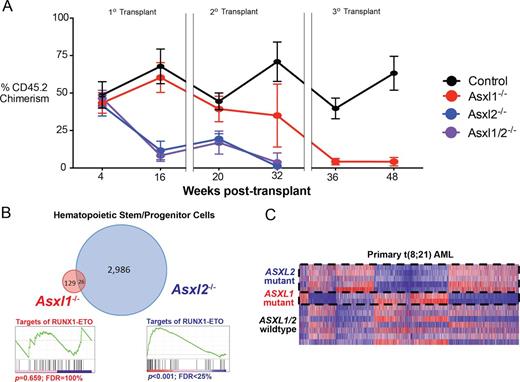Abstract
Mutations in Addition of Sex Combs Like 1 (ASXL1) are common in patients with myeloid leukemias. More recently, mutations in ASXL2, a paralog of ASXL1 with ~40% shared amino acid homology, have been discovered to occur specifically in patients with acute myeloid leukemia (AML) patients bearing the RUNX1-ETO (AML1-ETO; RUNX1-RUNX1T1) translocation and are amongst the most common mutations in RUNX1-ETO AML (mutated in 20-25% of patients). Although ASXL1 is critical for Polycomb Repressive Complex 2 function in myeloid hematopoietic cells and loss of Asxl1 recapitulates key aspects of myelodysplastic syndrome (MDS), the function of ASXL2 in normal or malignant hematopoiesis is unknown. We therefore set out to perform a functional comparison of ASXL1and ASXL2on hematopoiesis and transcription and determine the functional basis for frequent mutations in RUNX1-ETO AML.
In vitro analyses of ASXL2 insertion/deletion mutations revealed that these mutations resulted in substantial reduction of ASXL2 protein expression, stability, and half-life. We therefore generated Asxl2 conditional knockout (cKO) mice to delineate the effect of ASXL2 loss on hematopoiesis. Competitive (Fig. 1A) and noncompetitive transplantation revealed that Asxl2 or compound Asxl1/2 loss resulted in cell-autonomous, rapid defects of hematopoietic stem cell function, self-renewal, and number with peripheral blood leukopenia and thrombocytopenia but without any obvious MDS features- phenotypes distinct from Asxl1 cKO mice. Mice with heterozygous deletion of Asxl2 demonstrated an intermediate phenotype between control and homozygous cKO mice indicating a gene dosage effect of Asxl2 loss. RNA sequencing (RNA-seq) of hematopoietic stem/progenitor cells from Asxl2- and Asxl1-deficient mice revealed twenty-fold greater differentially expressed genes in Asxl2 cKO mice relative to Asxl1 cKO mice. Interestingly, genes differentially expressed with Asxl2 loss significantly overlapped with direct transcriptional targets of RUNX1-ETO, findings not seen in Asxl1 cKO mice (Fig. 1B). Asxl2 target genes appeared to also be targets of RUNX1, a key gene repressed by RUNX1-ETO to promote leukemogenesis. Consistent with this, genome-wide analysis of Asxl2 binding sites through anti-Asxl2 ChIP-seq revealed that Asxl2 binding sites substantially overlap with those of Runx1.
Overall, the above data suggest that Asxl2 may be a critical mediator of RUNX1-ETO mediated leukemogenesis by affecting the expression of RUNX1 and/or RUNX1-ETO target genes. RNA-seq of primary RUNX1-ETO AML patient samples revealed that ASXL2-mutant RUNX1-ETO patients form a distinct transcriptional subset of RUNX1-ETO AML (Fig. 1C) suggesting a specific role of ASXL2 in leukemogenesis. To functionally interrogate the role of ASXL2 loss in RUNX1-ETO mediated leukemogenesis we first utilized an in vitro model with RNAi-mediated depletion of ASXL1 or ASXL2 in the SKNO1 cell line (the only ASXL-wildtype human RUNX1-ETO cell line). RNA-seq revealed distinct target genes dysregulated by ASXL1 versus ASXL2 loss in these cells without any significant overlap. Anti-ASXL2, RUNX1, and RUNX1-ETO ChIPSeq in SKNO1 cells revealed significant co-occupancy of ASXL2 with RUNX1 and RUNX1-ETO binding sites. Moreover, analysis of histone modification ChIPSeq revealed an enrichment in intergenic and enhancer H3K4me1 abundance following ASXL2 loss in SKNO1 cells.
Next, to understand the in vivo effects of Asxl2 loss in the context of RUNX1-ETO, we performed retroviral bone marrow (BM) transplantation assays using RUNX1-ETO9a in Asxl2 cKO mice. In contrast to the failure of hematopoietic stem cell function with Asxl2 deletion alone, mice reconstituted with BM cells expressing RUNX1-ETO9a in Asxl2-deficient background had a shortened leukemia-free survival compared to Asxl2 -wildtype control.
Overall, these data reveal that ASXL2 is required for hematopoiesis and has differing biological and transcriptional functions from ASXL1. Moreover, this work identifies ASXL2 as a novel mediator of RUNX1-ETOtranscriptional function and provides a new model of penetrant RUNX1-ETO AML based on genetic events found in a substantial proportion of t(8;21) AML patients. Further interrogation of the enhancer alterations generated by ASXL2 loss in RUNX1-ETO AML may highlight new therapeutic approaches for this subset of AML.
No relevant conflicts of interest to declare.
Author notes
Asterisk with author names denotes non-ASH members.


